| |
 
All yoga is one, but there are different methods of teaching it. The
differences are usually about emphasis, such as focusing on strict alignment
of the body, coordination of breath and movement, holding the postures,
or the flow from one posture to another. Regardless of your age or fitness
level, you can find a style that will appeal to you and be most appropriate
for your particular body or personality type.
|
|
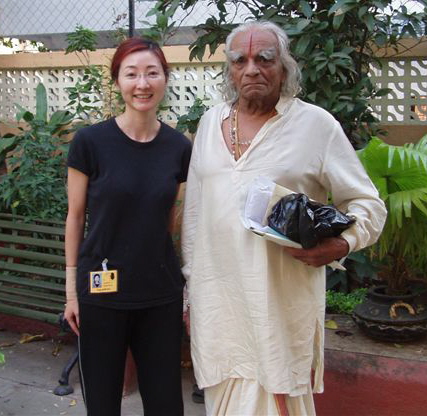
Josephine and B.K.S. Iyengar
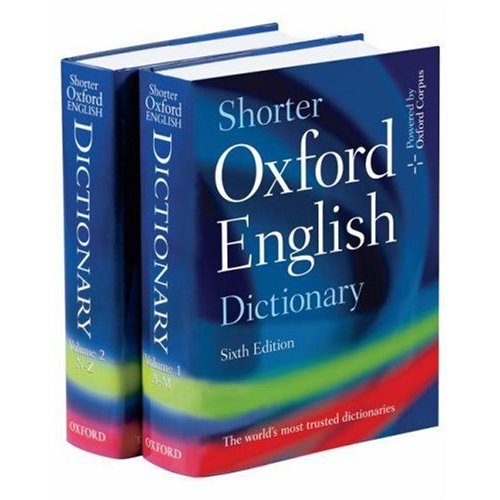
the word "Iyengar"
in
Oxford English Dictionary
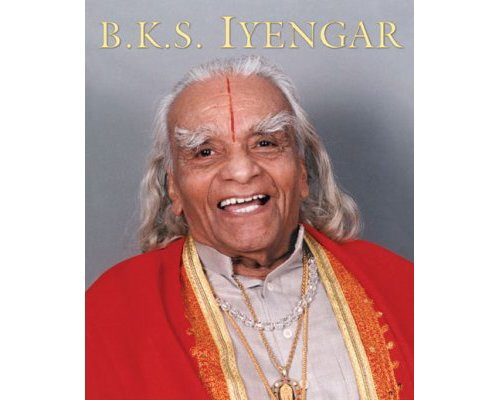
B.K.S. Iyengar among
Time's top 100 people |
Iyengar
Yoga
Iyengar yoga is probably the most widely recognized
Hatha yoga technique
in the Western world. The world renowned yoga teacher B.K.S. Iyengar is the founder of Iyengar Yoga. At the age of 16, his Guru (teacher) Sri
Tirumala Krishnamacharya (1888-1989)
introduced him to the physical discipline of yoga. Gradually he mastered the
art and science of yoga and took it to a higher level.
Iyengar yoga is regarded mostly for its rigorous scientific and therapeutic
approach, concentrating on correcting structural imbalances in the physical
body. Iyengar teachers pay particularly close attention to the placement of
the feet, hands and pelvis, as well as to the alignment of the spine, arms
and legs. The use of props, designed by B.K.S. Iyengar , such as wood
blocks, benches, sandbags, blankets, bolsters, wall ropes and straps as a
support system to achieve greater symmetry, extension and perfection in any
asanas (postures).
Iyengar
Yoga is also considered a powerful tool to relieve the stresses of
modern-day life. Through the practice of a system of asanas, it aims to
unite the body, mind and spirit for health and well being.
Ramamani
Iyengar Memorial Yoga Institute (RIMYI) is the heart and soul of Iyengar Yoga and is located in Pune, India. Its
directors are Yogacharya B.K.S. Iyengar's son Sri
Prashant Iyengar and grand daughter Abhijata Iyengar.
RIMYI welcomes Iyengar Yoga
practitioners all over the world. To apply attending the class, student
should be practicing "Iyengar Yoga" for at least 8 years, or Iyengar Yoga
teacher, and regular practice of Sirsasana (Headstand) and can stay for 8-10
minutes. The classes are generally booked a year or two in advance.
Iyengar Yoga has trained thousands of teachers,
who complete 3 years of rigorous training for the introductory level of
certification (higher-level certification may take a decade or more).
- 2003: The latest
edition of Oxford Dictionary of English defines "Iyengar" as "a type of hatha yoga focusing on the
correct alignment of the body, making use of straps, wooden blocks, and
other objects as aids to achieving correct postures. - ORIGIN named after
B.K.S. Iyengar (born 1918), the Indian yoga teacher who devised this
method."
- 2004: B. K.
S. Iyengar named as one of top 100 most influential people in the world by TIME magazine in the Heroes & Icons category
|
|
|
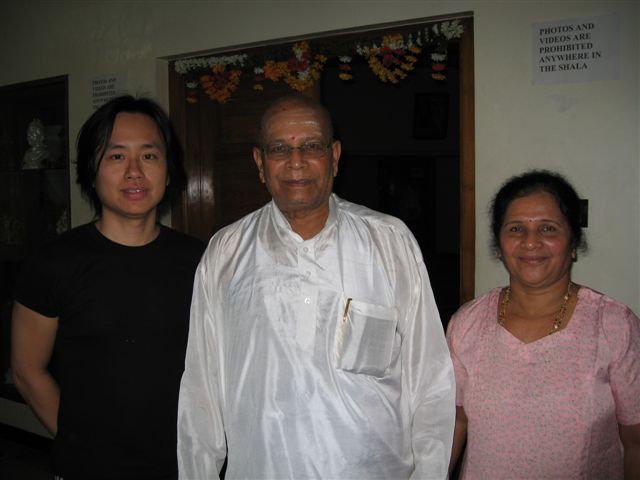
Kenny, Pattabhi
Jois and Saraswathi

Saraswathi
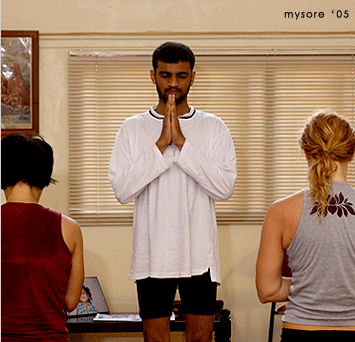
Sharath |
Ashtanga
Yoga
The Ashtanga yoga system is a rigorous practice comparable to the training
of an elite athlete. Consisting of 240 postures done in six successive
series (vinyasa) linked by the breath, Ashtanga yoga represents the most
intensive form of hatha yoga. The purpose of this continual flow of action
is to create heat which produce a cleansing or detoxifying effect on the
body. Ashtanga places equal emphasis on strength, flexibility and
stamina. Many fitness enthusiasts who thrive on intense workouts like this
style.
Sri Krishna Pattabhi
Jois (1915-2009) was the founder of Ashtanga Yoga at Ashtanga
Yoga Research Institute (AYRI) in
Mysore, India. Pattabhi Jois was born on the full moon day of July, 1915.
When he was 12 years old, he learned
yoga from Sri
Tirumala Krishnamacharya (1888-1989).
There is no formal yoga teacher training in AYRI.
But AYRI issues valid teaching authorizations and certifications for
Ashtanga Yoga teachers:
Authorized teachers
-
generally have made at least four trips
to AYRI Mysore, each trip lasts 3+ months; and
-
must also demonstrate appropriate attitude,
devotion to the Ashtanga Yoga practice, and
-
proficiency in the Primary Series (and
usually at least half of the Second Series) as determined by the directors
of AYRI
-
Authorized teachers generally are permitted
to teach only the Ashtanga Yoga Primary Series。
Certified teachers (by AYRI)
-
have completed at least the first three
series of Ashtanga Yoga; and
-
must demonstrate an appropriate level of
proficiency in these series as determined by the directors of AYRI; and
-
generally have made 8 or more annual
trips to AYRI Mysore, each trip stays at least 6 months; and
-
have at least 8-10 years of daily
Ashtanga Yoga practice
There is by no means visit AYRI in
Mysore for the sole purpose of getting authorized. Everyone can visit AYRI
for own practice under guidance. If you are interested in attending classes at the Mysore
AYRI,please download an application form, print, fill-in, and post it to Mysore AYRI.
Students are expected to stay for a
minimum of one month and for no longer than six months of study per year.
Now, the shala (school) is mainly managed by Saraswathi, Pattabhi Jois's
daughter and Sharath, Pattabhi Jois's
grandson.
|
|
|
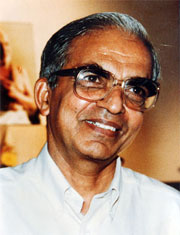
TKV Desikachar |
Viniyoga
The method of Viniyoga represents a kind of middle path between the exactness
of Iyengar yoga and the physically demanding Ashtanga yoga. It is based
on the principle of vinyasa krama, which means "an organized course of
yoga study", and combines asana, pranayama, meditation, text study,
counseling, imagery, prayer, chanting, and ritual. Yoga postures are
tailored to the physical needs and limitations of each student, taking into
account body type, emotional needs, cultural heritage, and interest.
Emphasis is on the spine, and breath is considered more important than how
the posture is done. Breath and movement are consciously coordinated and the
inhalations and exhalations are articulated in varying lengths and ratios.
Viniyoga was founded by TKV Desikachar at Krishnamacharya Yoga Mandiram in
Chennai, India. TKV Desikachar, son and student of Sri
Tirumala Krishnamacharya had
the privilege of living and studying with T. Krishnamacharya from 1960 until
Krishnamacharya's death in 1989.
|
|
|
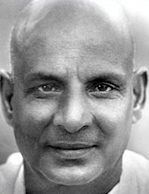
Swami Sivananda
(1887-1963)
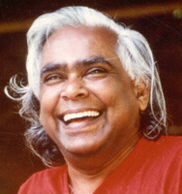
Swami Vishnu-devananda
(1927-1993) |
Sivananda
Yoga
Sivananda yoga incorporates a five-point method of practice, which includes
proper exercise, breathing, deep relaxation, vegetarian diet, positive
thinking and meditation. Following a standard format, Sivananda hatha
yoga classes are based on a routine of breathing exercises, sun salutations,
a series of 12 classic yoga postures and relaxation. A short mantra chant
and prayers begin and end each class.
Swami Vishnu-devananda, the founder of The
International Sivananda Yoga Vedanta Centers, and he learned yoga from his
guru, Swami Sivananda.
|
|
|

Paramahansa Yogananda
(1893-1952) |
Ananda Yoga
Ananda Yoga was founded by Paramahansa
Yogananda.
This method combines the physical and spiritual. The purpose of Ananda
yoga is to clear and energize the system in preparation for meditation.
Each posture is viewed as a way to expand, or heighten, self awareness.
This process is enhanced through the use of affirmation, a distinctive
feature of this system.
Ananda yoga also teaches a series of poses called
"energenization exercises". These exercises involve tensing and relaxing
different parts of the body, coupled with breathing exercises to send
energy to them. Another characteristic of this technique is the emphasis
it places on deeply relaxing into poses, keeping in mind that hatha yoga
is a preparation for meditation. |
|
|

Swami Satchidananda |
Integral
Yoga
Integral yoga
was founded by Swami
Satchidananda, and the headquarter, Satchidananda
Ashram and Retreat Center at Yogaville is located in Virginia, USA.
Integral yoga combines all the paths of yoga -- asana (postures), pranayama
(controlled breathing), selfless service, prayer, chanting, meditation
and self-inquiry -- into one approach. It emphasizes a more meditative
rather than anatomical approach. Practicers of this style of yoga are
encouraged to be "easeful in body, peaceful in mind and useful in life".
Integral yoga classes follow a set pattern and are 75 minutes in length.
This includes 45 minutes of asanas, a deep relaxation, a breathing sequence
and ends with a meditation. Although challenging, the feeling of the class
is gentle and meditative and reflects a traditional approach that benefits
all aspects of the individual.
|
|
|
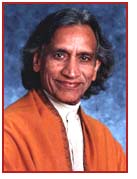
Amrit Desai |
Kripalu
Yoga
The founder is Amrit
Desai. In 1966, Amrit
Desai founded the Yoga Society of Pennsylvania, a non-profit organization.
The name of the Society was later changed to Kripalu
Yoga Fellowship in Massachusetts.
Less concerned with the structural detail of the postures, Kripalu yoga
has been described as "meditation in motion". It emphasizes the student's
metal and emotional states as the poses are held, while encouraging a
gentle, compassionate and introspective approach. Postures are held for
a long time so as to explore and release emotional and spiritual blocks.
This inner-directed form of hatha yoga consists of three stages: willful
practice, will and surrender, and finally, surrendering to the body's
wisdom. Within each of the three stages, poses are offered in different
intensities: gentle, moderate, and vigorous. In addition, spontaneous
postures and sequences of postures are encouraged, guided by the body's
internal awareness.
|
|
|
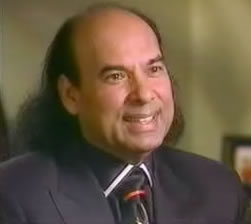
Bikram
Choudhury |
Bikram
Yoga
Also called "Hot Yoga". Bikram Choudhury, the creator of Bikram
Yoga, the headquarter is Bikram Yoga College of India and located in
Los Angeles, USA.
Working with a sequence of 26 postures in a heated room
(minimum 40.5oC or
105oF) combines
with two breathing technique. |
|
|
| |
Kundalini
Yoga
Kundalini yoga is an ancient practice designed to bring forth the "Kundalini",
or reservoir of energy, stored at the base of the spine. Through the use
of breath, posture, chanting and meditation, this energy is stimulated
and consciously directed through the chakras or energy centers along the
spine. Several breathing techniques are emphasized -- alternate nostril
breathing; slow, diaphragmatic breathing and a dynamic technique called
breath of fire.
|
|
|


